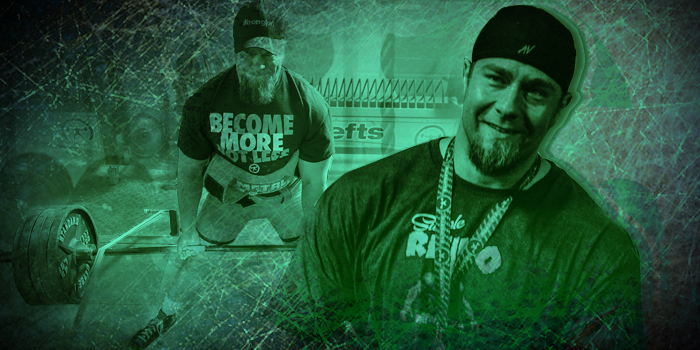
What’s your number? No, not your phone number. If you are reading this, you have a number in your head that you are chasing. That number may have eluded you in the past or it may be your next rung on your climb to greatness. It doesn’t matter if that number is 100 or 1100; the process of achieving your goals is the same. Each workout, each week, and each cycle should put you one step closer. With the correct indicators and objectives, you can speed up the process of reaching your goals.
I want to share the thought process and the goal-setting “pyramid” I use for my clients and myself. When written out, it will help easily clarify daily, weekly, and monthly needs for continual progress. It also speeds up troubleshooting when things begin to stall. If you use the conjugate method, you will see parallels to that style of programming. First, you need to know what you want to accomplish.
Ultimate Goal
The ultimate goal is the biggest goal you are working toward. This can change after every training cycle or meet. No matter your goal, it needs to fit into the S.M.A.R.T acronym. It must be smart, measurable, action-oriented, reasonable, and time-based. The purpose of this article is not choosing the right goal, but it is important to mention that portion in this section. Every 12 to 16-week block of training should have goals that are either attempted at a meet or on a testing day. Things happen and that number is not always achievable. Whether you crush that number or miss it, after each block of training you should adjust your goal, the indicators, and/or the training objectives. But without a goal, you won’t be able set the other pieces into place.
Example 1: My current goal is to deadlift 800 pounds at 220. This would be down a weight class from my previous 800-pound deadlift.
Example 2: My training partner Dan has a goal of benching 400 pounds raw. Each meet, he takes steps toward that goal. More work is required after each step he takes.
Indicators (Supplemental Goals)
You can call them indicators or supplemental goals. No matter what you call them, this level is what you will use to determine if you are closer to your goal or if it is attainable at that moment. During meet prep, if you are not improving on these numbers, you will need to scale back your attempts. If you are breaking records on three or four indicators, know that you are ready for a shot at that goal. The items in this list are the items that, when making progress, prove you are getting stronger. They will need to be improved upon to make it possible to reach your goal. This is why you don’t have to test constantly with the main lifts when using a conjugate program. Break your records on these exercises and you are stronger than before. But remember, your exercises must be chosen correctly.
Example 1: If I break records for my conventional deficit deadlift (620 pounds), cambered bar good morning (455 to 500 pounds), and sumo deadlift raised three inches in gear (755 pounds), I know my back, hips, hamstrings, and abs are strong enough to break my deadlift record on meet day.
Example 2: Dan needs to break records with his floor press, close grip press, two-board press, and steep incline press. When he is breaking records on these, he is ready to break his bench press record.
Objectives (Assistance Goals)
The assistance work objectives are the base to reaching your ultimate goal. If you look at it like a pyramid, this is at the bottom and is the widest stretching. These should be measured on a weekly or workout basis. Some will be measured on a volume level rather than on a weight level. You will need to work hard but the amount of work is just as important. Increasing your pushdowns by 10 pounds is not necessarily going to transfer into a new floor press PR. Make sense? Just keep working to do more work, better. When you first started lifting you needed much less stimulus to make improvements. As you become more advanced, you need more and more work. This is why your GPP levels need to remain high and each week you need to check off certain boxes for continual progress.
RECENT: Six Off-Season Bench Cycles to Replace Dynamic Effort Work
Example 1: To deadlift 800 pounds I need 80,000 thousand pounds of reverse hypers per week, 30 sets of hamstrings per week (including sled, treadmill, ball carries, and direct hamstring work), ab work three days per week, and five minutes or more of direct upper back work per week.
Example 2: Dan needs 22 or more sets of lats per week, 12 work sets of triceps per workout (split between extensions or dips and pushdowns), and upper back work four days per week for three minutes or more per workout.
Breaking It Down Further
What if you are stuck? What if one indicator is not moving? The indicator you chose may not be an indicator at all. If that is the case, it can be dropped from your list in place of another exercise. It doesn’t mean you don’t do that exercise. This would also be the case if you had two indicators moving and were still getting closer to your ultimate goal.
When your main lift is stuck and you are not breaking records on your indicators, you might need to break things down further. Create a new pyramid and this time add your stuck lift to the top. With your indicator at the top of the pyramid, you will then have to dial in your indicators for that lift. For example, if your floor press moves to your ultimate goal slot, your supplemental goals might include dumbbell pressing, overhead pressing, and JM pressing. Your objectives each workout will then be used to improve the dumbbell press, overhead press, and the JM press. As your training age increases, exercises will fall off and your pyramid will be refined, making progress even faster.
When you first start looking at goals this way, you might choose the wrong exercises. As you fine-tune the bottom levels, you will figure out where you need to be. I am sure some lifters would say to just work hard and not think about it so much, but I like to know what variables are leading to my success and what I should repeat. I don’t want to play a guessing game every cycle. Once you know what works, it will require less and less monitoring.











Heres a really good review of affilorama:
https://dreampresent.weebly.com
Keep up the great content! :)